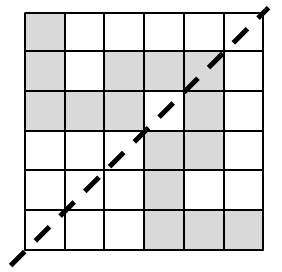
| Optimal Symmetric Paths |
You have a grid of n rows and n columns. Each of the unit squares contains a non-zero digit. You walk from the top-left square to the bottom-right square. Each step, you can move left, right, up or down to the adjacent square (you cannot move diagonally), but you cannot visit a square more than once. There is another interesting rule: your path must be symmetric about the line connecting the bottom-left square and top-right square. Below is a symmetric path in a 6 x 6 grid.

Your task is to find out, among all valid paths, how many of them have the minimal sum of digits?
2 1 1 1 1 3 1 1 1 1 1 1 2 1 1 0
2 3
The Seventh Hunan Collegiate Programming Contest
Problemsetter: Rujia Liu, Special Thanks: Yiming Li & Jane Alam Jan